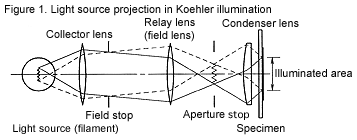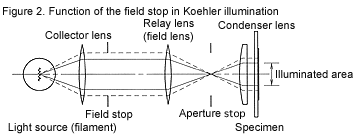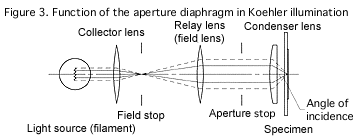Koehler illumination
Koehler illumination, invented in 1893 by August Koehler, avoids flares and ghosting, and is essential for activities such as microscope photography.
Conditions for Koehler illumination
- 1. An image of the lamp filament is projected onto the aperture diaphragm
- The field stop is projected onto the specimen surface
- The aperture diaphragm and the field stop may be moved independently

Function of the field stop
The field stop is used to limit the area of illumination on the specimen. Limiting the amount of light cast helps eliminate flares and ghosting, leading to sharper images.

Function of the aperture diaphragm
The aperture diaphragm limits the projection of the light source (filament), which enables adjustment of brightness of the field of view. The angle of incidence may also be adjusted with the aperture diaphragm, which allows adjustment of contrast resolution and focal depth. Focal depth refers to the depth of thickness within the specimen that comes into sharpest focus.

- [Note 3] Figure 3 shows only those light rays from the light source (filament) that are traveling parallel to the optical axis.